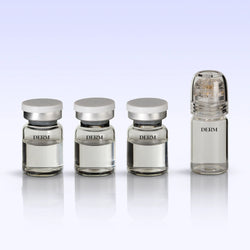Understanding Skin Changes During Menopause: Your Complete Guide

Written by Our Editorial Team
6 MINUTES READ
When it comes to menopause, most women expect the hot flashes and mood swings
But what often catches many by surprise are the dramatic changes in their skin.
Let's dive into what's really happening to your skin during this transition and, more importantly, what you can do about it.

The Hormonal Connection
During menopause, estrogen levels begin to decline significantly.
While this affects many aspects of your body, your skin shows some of the most visible changes.
Why? Because estrogen plays a crucial role in:
- Maintaining skin thickness
- Supporting collagen production
- Keeping skin hydrated
- Managing oil production
- Supporting skin healing
The Top 5 Skin Changes During Menopause
1: Increased Dryness As estrogen levels drop, your skin produces less hyaluronic acid – your body's natural moisturizer. This leads to what many women describe as "persistent dryness" that regular moisturizers don't seem to fix.
2: Loss of Elasticity Collagen production drops by about 30% in the first five years of menopause.
This sudden decrease leads to:
- More visible fine lines
- Sagging, especially around the jawline
- Loss of skin "bounce back"
3: Thinner Skin Your skin literally becomes thinner during menopause, making it more delicate and prone to damage.
This can result in:
- Increased sensitivity
- Easier bruising
- Slower healing
4: Changes in Oil Production While some women experience dryness, others might notice unexpected breakouts. This hormonal imbalance can lead to adult acne, even if you've never had it before.
5: Enlarged Pores As skin loses elasticity, pores can appear larger. Combined with changes in oil production, this can affect skin texture and appearance.

Real Solutions for Real Changes
The good news?
Understanding these changes means you can take targeted action to address them.
Hydration Strategy Your skin needs more help retaining moisture during and after menopause.
Remember: Beautiful skin comes from understanding what works and why.
Look for products containing:
- Hyaluronic acid (particularly at 3% concentration for deeper hydration)
- Ceramides
- Peptides
Barrier Support Strengthening your skin barrier becomes crucial during this time.
Focus on:
- Gentle cleansing
- Rich moisturizers
- Products that support barrier repair
Collagen Boost While topical products can't replace estrogen's effects entirely, they can help support your skin's structure:
- Use products with peptides
- Consider collagen-stimulating ingredients
- Protect existing collagen with antioxidants
Creating Your Menopausal Skincare Routine
Morning:
1. Gentle cleanser
2. Hydrating serum (look for 3% hyaluronic acid concentration)
3. Antioxidant protection
4. Moisturizer
5. Broad-spectrum SPF (crucial as skin becomes more sun-sensitive)
Evening:
1. Thorough but gentle cleansing
2. Hydrating serum
3. Rich moisturizer
4. Targeted treatments for specific concerns
Professional Tips for Success
1. Be Consistent Results come from regular care, not occasional treatments.
2. Layer Products Correctly Apply products from thinnest to thickest consistency.
3. Listen to Your Skin Adjust your routine based on how your skin responds.
Looking Forward
While menopausal skin changes are natural, they don't have to be accepted without action.
The Derm™ skincare, particularly our 3% Hyaluronic Acid Serum, was developed with these specific changes in mind.
Our high-concentration formula helps address the significant decrease in natural hyaluronic acid production during menopause, providing deep hydration where your skin needs it most.
Remember, menopause is not just another phase in aging – it's a distinct period that requires specific skincare approaches.
By understanding these changes and using products designed for menopausal skin, you can maintain healthy, radiant skin throughout this transition and beyond.





